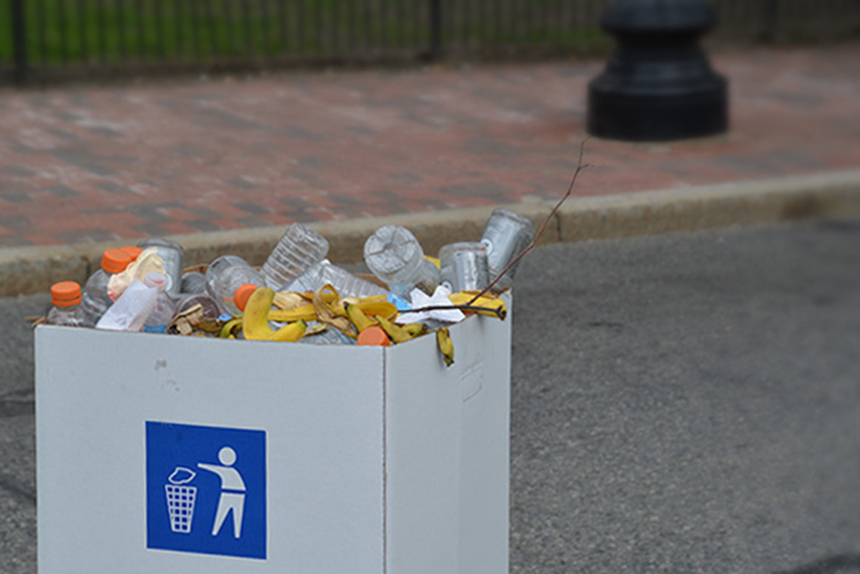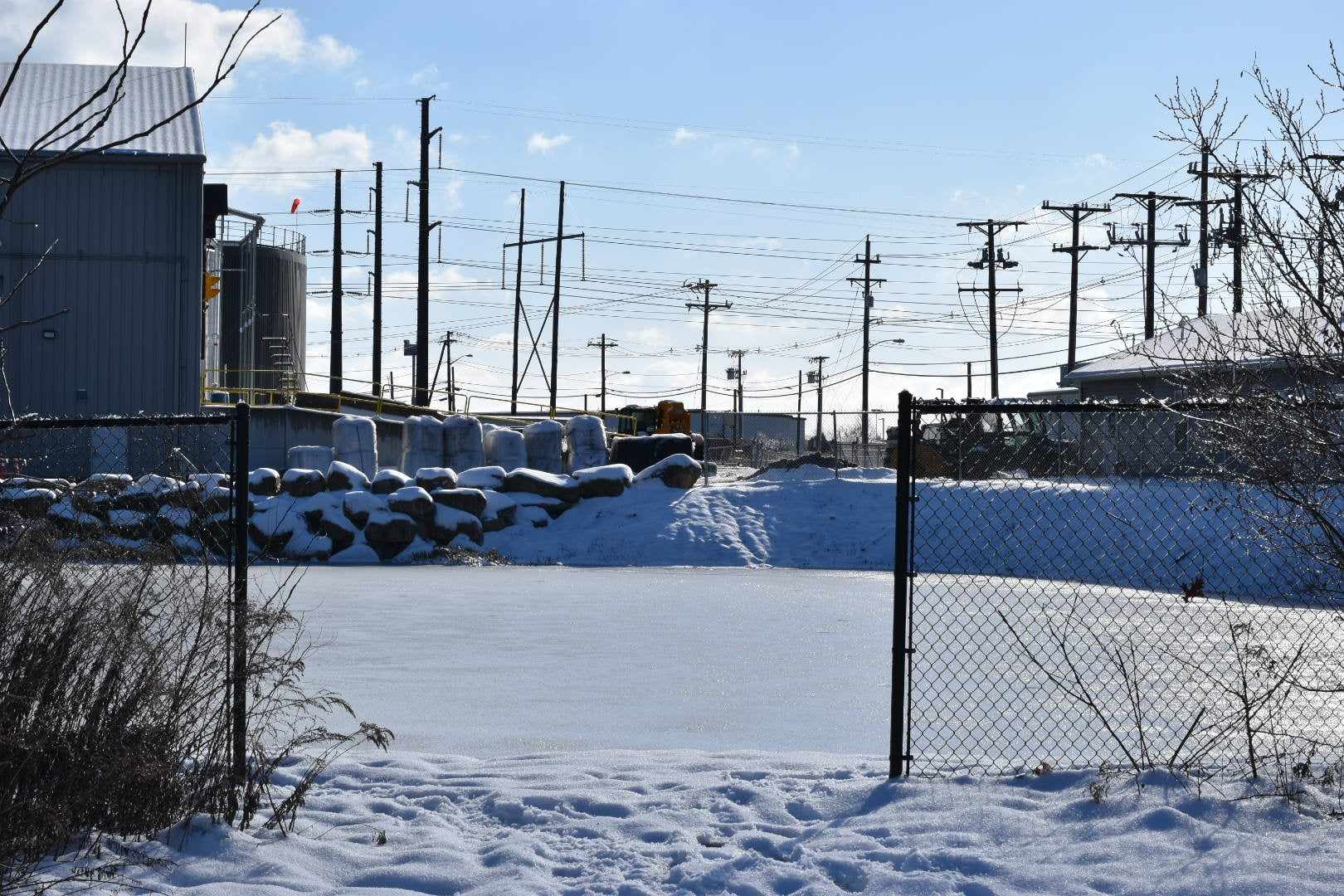Global Trends and Bad Local Behavior Limit Recycling’s Profitability
February 9, 2016
Since switching to single-stream recycling in June 2012, Rhode Island’s recycling rate has risen less than 2 percent and remains stubbornly below 25 percent. During that same period, the market for sorted and baled recyclables, the end product of the statewide recycling program, has bottomed out.
The result is less revenue for the Johnston-based Rhode Island Resource Recovery Corporation (RIRRC) — the quasi-state agency that manages the recycling program — from the sale of recyclables, and less revenue for municipalities, which receive a share of the recycling program’s profit based on their individual contributions to the total amount recycled by the state.
In fiscal 2015, RIRRC shared $551,700 with the state’s municipalities. By contrast, it shared about $1.5 million in 2014, despite a modestly lower recycling rate. In 2011 and 2012, RIRRC shared about $1.9 million. This year, the agency that runs the Central Landfill expects to share less than $700,000, according to Sarah Reeves, RIRRC’s director of recycling services.
“The market is volatile,” said Reeves, who noted that in 2009 the market for recyclables was so poor that there was no profit to share. “It’s cyclical, and will bump back up again, but probably not for another 18 months or so.”
The recycling program’s smaller profit margins are mainly the result of cheap oil. “Low oil prices are great for heating your home and driving your car, but not for recycled plastics and people who want to sell plastic,” Reeves said.
When oil prices are low, it’s cheaper for manufacturing companies to buy virgin plastic — a petrochemical product — than to buy recycled plastic. In fact, the market rate of recyclable plastics has dropped more than 50 percent in the past two years, she said.
Decisions made globally also impact the state’s recycling-program revenue. During the past few years, China has sourced more recyclables from within its borders, while demanding a less-contaminated product from overseas providers. Furthermore, as China’s economic growth slows, its overall demand for recyclables has dropped.
The more contaminated a bale of recyclables is, the less value it has. “A bag of dirty diapers or last night’s leftovers can degrade the quality of a whole load of recyclables,” Reeves said. “When you have other pressures in the market, like we do right now, the recyclables have to be pristine.”
A $16.9 million sorting machine that went on-line in June 2012 has helped RIRRC reduce contamination. For example, the machine automatically sorts different types of plastics, which makes the end product less contaminated and, thus, more valuable. It also expanded upon the types of items that can be placed in recycling bins, opening new markets for the program.
Singular purpose
The new machine ushered in the age of single-stream recycling in Rhode Island. The ability to recycle paper and cardboard in the same recycling bin as glass, metal and plastic containers was expected to boost Rhode Island’s overall recycling rate by making recycling easier.
Single-stream recycling led many municipalities to replace their traditional green and blue recycling bins with a single, larger rolling tote with a hinged lid, and switch to waste haulers with automated collection trucks. This switch to automated collection trucks has saved cities and towns money, because collections can be completed by the driver alone. Gone are the days when additional workers hopped on and off the back of the truck emptying recycling bins manually. The new, lidded totes also cut down on street litter that often blown out of the traditional green and blue recycling bins.
Reeves said municipalities switching to larger recycling totes and automated collection was a primary goal of the switch to single-stream recycling.
“People complained that their [old] recycling bins were too small,” she said. “The bigger carts are large enough for a week’s worth of recycling, keep neighborhoods neat and clean, and keep the recyclables dry.”
Unfortunately, automated collection of recyclables has, in some cases, resulted in greater contamination. When waste haulers employed two- or three-man recycling crews, they could use their judgement about whether to empty a contaminated recycling bin into their truck. Now, the driver operating the arm on the recycling truck doesn’t see the contents of a tote until it’s already being emptied via a camera. At that point, it’s too late to avoid contaminating the rest of the truck’s load.
While few people would like to see more recyclables delivered to Johnston than Reeves, she isn’t concerned by the slow growth of the state’s recycling rate.
“There are many factors to recycling rates, and many are out of our control,” she said.
For example, as newsprint declines as an overall portion of residential waste, so too does its contribution to Rhode Island’s recycling rate. Similarly, companies are switching from heavy glass containers to lighter plastic ones, and those that already use plastic are making their packaging thinner and smaller. Lighter packaging registers negatively in terms of the state’s recycling rate, but the overall volume of recyclables has actually increased, Reeves said.
Reeves noted that the amount of recyclables being landfilled is relatively small, according to RIRRC’s forthcoming solid-waste study. She said the weight-based recycling rate metric should be de-emphasized in favor of a metric that measures how many pounds of garbage each person contributes to the landfill.
Switching to single-stream recycling was a good investment, according to Reeves. She said the $16.9 million sorting machine will pay for itself by its seventh year in operation, despite the slow growth of the recycling rate and poor market for recyclables.
Providence losing money
While most municipalities grew their recycling rate after switching to single-stream recycling, Providence’s recycling rate dropped, from 14.5 percent in 2011 to 9.5 percent in 2014. Between the poor market for recyclables and the decline in its recycling rate, Providence is receiving relatively little money from RIRRC’s recycling profit-share program.
In fiscal 2015, the city received $33,000 from the profit-share program, down from $100,000 in 2014. In 2011, when the city’s recycling rate and the market were better, Providence was awarded $206,000.
Money from the recycling profit-share program must be used on waste-reduction efforts, and, according to Leah Bamberger, Providence’s sustainability director, it accounts for almost all of the city’s spending on such efforts. Therefore, as the money Providence receives from the profit-share program declines, so too does the city’s capacity to expand and maintain waste-reduction efforts.
Providence Composts!, the city’s small-scale residential compost program, is one example of a program being squeezed. Providence Composts! was funded entirely by the profit-share program last year to the tune of $20,000, according to Bamberger.
This year, much — or possibly all — of the city’s profit-share program funds will be invested in handheld ticketing devices to help enforcement personnel address recycling violations more efficiently, according to Francisco Ramirez, associate director of environmental control for the city’s Department of Public Works. This investment may improve the city’s recycling rate, but it could be a setback for the city’s composting initiative.
“Educating residents about recycling requires a continuous effort,” Bamberger said. “If you asked someone in marketing what it would cost to get a detailed message across to (the large and diverse population of Providence) they’d probably give you a number in the millions (of dollars), not in the tens of thousands.”
The drop in Providence’s recycling rate is generally blamed on the confluence of two changes: the deployment of new residential trash totes that coincided with the launch of single-stream recycling; RIRRC’s nearly concurrent demand for less contaminated recyclables in response to market pressures, according to both Bamberger and Ramirez.
When residents received new, gray totes in 2013, they were supposed to use them for trash, and begin to use their existing trash totes — a bigger green bin — for recyclables. The smaller green and blue recycling bins were phased out. The message failed to reach all residents, and, as a result, many continued to dispose of their trash in what had become their recycling bin.
This contamination issue is ongoing. “Our challenge with contaminated loads is not that people are putting the wrong plastic in their recycling bins, or that they’re not rinsing their containers. It’s that there are bags of trash, bags of leaf and yard waste, and construction debris — things that people just don’t really know how to get rid of — in recycling bins,” Bamberger said.
Providence’s contamination problem is costly. RIRRC doesn’t charge municipalities to deliver recyclables to its sorting facility, but it does charge $32 a ton to tip waste into the Central Landfill.
If contaminated recyclables are delivered, RIRRC rejects them. The entire load — made up of mostly recyclables — is then sent to the landfill and buried. The municipality responsible for the contaminated load is fined $250, plus the per-ton cost of tipping that load in the landfill.
To make matters worse for the city, only Providence’s first 50,000 tons of waste annually are billed at $32 a ton, according to Bamberger. Each ton thereafter costs the city $54. Currently, the waste Providence purposefully sends to the landfill weighs about 47,000 tons annually.
In fiscal 2015, RIRRC rejected 189 loads of recyclables from Providence, according to Bamberger. The rejected loads cost the city $47,250 in fines, plus about $54,000 to tip the 1,000 tons of mostly recyclable waste into the landfill.
In order to avoid the $250 fine for contaminated loads, Providence’s waste haulers are instructed to “self-reject” loads of recyclables that they believe would be rejected by RIRRC. Drivers decide whether to self-reject by observing a camera that shows the waste as bins empty into their trucks and based on their past experience, according to Bamberger.
If a driver deems a load contaminated, he or she bypasses the recycling facility and tips the recyclables directly into the landfill. The city pays the per-ton cost of disposing of the recyclables in the landfill, but avoids the $250 fine.
In fiscal 2015, Providence waste haulers self-rejected 16,000 tons of mostly recyclable material at a cost of about $798,000, according to Bamberger. Furthermore, each rejected load lessens the city’s recycling rate, which results in less money coming back to the city from the profit-share program.
Providence officials are focused on improving its recycling rate. For a second year, it has secured a $5,000 grant from RIRRC to fund a recycling-improvement pilot program. The program trains volunteers to canvass neighborhoods and help residents improve recycling habits. Meanwhile, they gather feedback from residents so the city can ensure its services are aligning with its residents’ needs.
The city is focusing the grant funding on neighborhoods from which recycling loads are sometimes rejected for contamination. The goal is to reduce the number of rejected loads from these borderline-compliant neighborhoods. Lessons learned from the pilot neighborhoods will be applied to neighborhoods with consistent contamination issues, Bamberger said.
The city also has invested in handheld ticketing devices that allow enforcement personnel to go curb to curb, inspect recycling bins, and issue warnings and tickets on the spot. The associated software allows the city to issue warnings and tickets by mail to landlords in a timely fashion so that all involved parties are alerted to the issue quickly, according to Ramirez.
The city also is incentivizing good behavior. Bamberger said her office is asking known recycling violators to pledge to change their habits in exchange for rewards, such as tickets to the Kennedy Plaza skating rink.
Both Bamberger and Ramirez recognize that change will take time. In the meantime, Ramirez is considering a less-conventional, short-term solution: a company would be contracted by the city to pre-sort contaminated recycling loads prior to their delivery to RIRRC. If a local company can provide this service for less money than the city is currently spending on fines and tip fees for its contaminated recyclables, than it’s a viable option, he said.
Categories
Join the Discussion
View CommentsRecent Comments
Leave a Reply
Your support keeps our reporters on the environmental beat.
Reader support is at the core of our nonprofit news model. Together, we can keep the environment in the headlines.
We use cookies to improve your experience and deliver personalized content. View Cookie Settings




"Providence’s recycling rate dropped, from 14.5 percent in 2011 to 9.5 percent in 2014." Pathetic! Come on Rhode Island, we can do better.
very interesting article